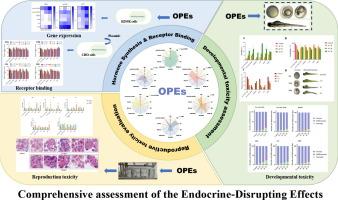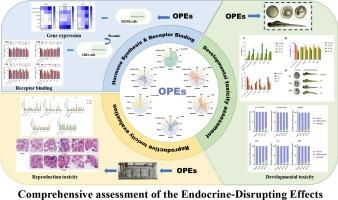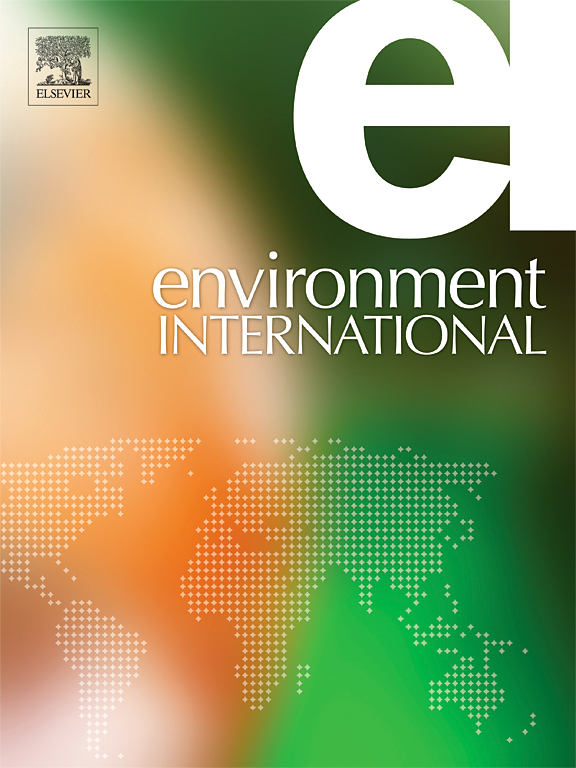A comprehensive evaluation of the endocrine-disrupting effects of emerging organophosphate esters
IF 9.7
1区 环境科学与生态学
Q1 ENVIRONMENTAL SCIENCES
引用次数: 0
Abstract
The ubiquitous presence of organophosphate esters (OPEs) in the environment has prompted growing concerns about their potential health risks, particularly their endocrine-disrupting effects. This study comprehensively evaluated the endocrine-disrupting properties of six emerging OPEs: five aryl-OPEs (2-ethylhexyl diphenyl phosphate (EHDPP), tris (2-biphenylyl) phosphate (TBPP), resorcinol bis (diphenyl phosphate) (RDP), 4-hydroxyphenyl diphenyl phosphate (para-OH-TPHP), and 3-hydroxyphenyl diphenyl phosphate (meta-OH-TPHP) and one alkyl-OPE, triallyl phosphate (TAP). Our findings revealed that all tested aryl-OPEs exhibited antagonistic effects on one or more hormone receptors. Importantly, para-OH-TPHP demonstrated the most potent antagonistic activity, inhibiting estrogen receptor α (ERα), thyroid hormone receptor β (TRβ), glucocorticoid receptor (GR), and mineralocorticoid receptor (MR) with the concentration of test compounds showing 20 % relative inhibitory concentration (RIC20) value below 10−6 mol/L (M). RDP antagonized ERα and cortical receptors (GR and MR), TBPP affected TRβ and GR, while EHDPP and meta-OH-TPHP targeted MR. Regarding steroidogenesis, para-OH-TPHP significantly inhibited genes for estrogen (cyp19) and cortisol synthesis (cyp11b2), and along with meta-OH-TPHP, EHDPP, TAP, and RDP downregulated cyp11a1, a rate-limiting enzyme in hormone synthesis. All compounds caused malformations and swimming abnormalities in zebrafish embryos/larvae at concentrations of 10−7 M or higher, with para-OH-TPHP showing nearly 50 % peak induction. Furthermore, the six compounds tested influenced genes associated with the hypothalamic-pituitary–gonadal (HPG) axis in both zebrafish larvae and adult female zebrafish, in addition to affecting the reproductive behavior of zebrafish. A weighted scoring system was employed to rank the endocrine-disrupting potency of the OPEs, with para-OH-TPHP exhibiting the highest risk, followed by EHDPP, RDP, TBPP, meta-OH-TPHP, and TAP. Collectively, our results highlight the significant endocrine-disrupting effects of emerging OPEs, underscoring the urgent need for further research to assess their potential health implications.


全面评估新出现的有机磷酸酯对内分泌的干扰作用
环境中无处不在的有机磷酸酯(OPEs)引起了人们对其潜在健康风险的日益关注,尤其是其干扰内分泌的作用。本研究全面评估了六种新出现的 OPE 的内分泌干扰特性:五种芳基 OPE(2-乙基己基二苯基磷酸酯 (EHDPP)、三(2-联苯基)磷酸酯 (TBPP)、间苯二酚双(二苯基磷酸酯) (RDP)、4-羟基二苯基磷酸酯 (para-OH-TPHP) 和 3-羟基二苯基磷酸酯 (meta-OH-TPHP))和一种烷基 OPE(磷酸三烯丙酯 (TAP))。我们的研究结果表明,所有测试的芳基-OPE 都对一种或多种激素受体具有拮抗作用。重要的是,对位-OH-TPHP 具有最强的拮抗活性,可抑制雌激素受体 α(ERα)、甲状腺激素受体 β(TRβ)、糖皮质激素受体(GR)和矿物质皮质激素受体(MR),测试化合物的 20% 相对抑制浓度(RIC20)值低于 10-6 摩尔/升(M)。RDP 可拮抗 ERα 和皮质受体(GR 和 MR),TBPP 可影响 TRβ 和 GR,而 EHDPP 和 meta-OH-TPHP 则针对 MR。在类固醇生成方面,对位-OH-TPHP 显著抑制雌激素(cyp19)和皮质醇(cyp11b2)合成的基因,与元-OH-TPHP、EHDPP、TAP 和 RDP 一起下调了 cyp11a1(激素合成的限速酶)。当浓度为 10-7 M 或更高时,所有化合物都会导致斑马鱼胚胎/幼体畸形和游泳异常,其中对位 OH-TPHP 的诱导峰值接近 50%。此外,所测试的六种化合物除了影响斑马鱼的生殖行为外,还影响了斑马鱼幼体和成年雌性斑马鱼体内与下丘脑-垂体-性腺轴(HPG)相关的基因。我们采用加权评分法对 OPE 的内分泌干扰效力进行了排名,其中对位 OH-TPHP 的风险最高,其次是 EHDPP、RDP、TBPP、meta-OH-TPHP 和 TAP。总之,我们的研究结果凸显了新出现的 OPE 对内分泌的重大干扰作用,强调了进一步研究评估其潜在健康影响的迫切性。
本文章由计算机程序翻译,如有差异,请以英文原文为准。
求助全文
约1分钟内获得全文
求助全文
来源期刊

Environment International
环境科学-环境科学
CiteScore
21.90
自引率
3.40%
发文量
734
审稿时长
2.8 months
期刊介绍:
Environmental Health publishes manuscripts focusing on critical aspects of environmental and occupational medicine, including studies in toxicology and epidemiology, to illuminate the human health implications of exposure to environmental hazards. The journal adopts an open-access model and practices open peer review.
It caters to scientists and practitioners across all environmental science domains, directly or indirectly impacting human health and well-being. With a commitment to enhancing the prevention of environmentally-related health risks, Environmental Health serves as a public health journal for the community and scientists engaged in matters of public health significance concerning the environment.
 求助内容:
求助内容: 应助结果提醒方式:
应助结果提醒方式:


